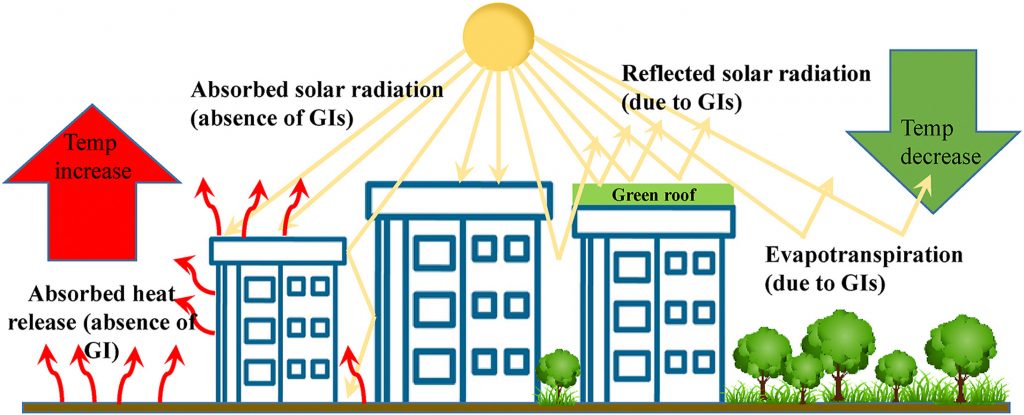 Abraham Lincoln
If given the truth, the people can be depended upon to meet any national crisis...
Abraham Lincoln
If given the truth, the people can be depended upon to meet any national crisis...
 Guildford news...
for Guildford people, brought to you by Guildford reporters - Guildford's own news service
Guildford news...
for Guildford people, brought to you by Guildford reporters - Guildford's own news service
Trees Are the Coolest Way to Reduce Urban Heat Island Effect, Surrey University Study Finds
Published on: 20 Nov, 2020
Updated on: 22 Nov, 2020
 Air pollution experts from the University of Surrey have found green infrastructure (GI), such as trees, can help reduce temperatures in many cities and towns.
Air pollution experts from the University of Surrey have found green infrastructure (GI), such as trees, can help reduce temperatures in many cities and towns.
An urban heat island is a built-up area significantly warmer than its surrounds. Usually, the temperature difference is larger at night.
With the UK government pledging 300,000 new homes every year, many towns and cities could experience temperature rises caused by more vehicles and building activity.
In a paper published by Environmental Pollution, experts from Surrey’s Global Centre for Clean Air Research (GCARE) modelled how a UK town would be affected if its urban landscape included different types of GI.
The study focused on simulating temperature increases in Guildford under different GI cover (trees, grassland and green roofs). The team’s computer modelling systems found 78 per cent of Guildford was covered by grassland and trees.
The research team investigated five scenarios:
- What is the status quo with the present GI?
- What would happen if the town had no GI?
- What would happen if the GI was only trees?
- What would happen if the GI was only green roofs?
- What would happen if the GI was only grassland?
The GCARE team found trees are the most effective form of GI, showing Guildford would be 0.128oC cooler if trees replaced all forms of GI.
The team also found trees are the best solution for the reduction in temperature spikes because they can better shade surfaces and influence aerodynamic mixing of air in the atmosphere caused by enhanced turbulence.
Professor Prashant Kumar, director of GCARE at the University, said: “As policymakers and political leaders rightly look to solve the nation’s housing crisis, it is vitally important they consider how this influx of new urban infrastructure will impact our environment and our planet.
“I hope our study will give decision-makers the information they need when they are deciding which green infrastructure to establish in our communities.
“Our results suggest that, given a choice, trees are the most effective at reducing the urban heat island effect many of our towns face.”
Borough Cllr John Rigg (R4GV, Holy Trinity), lead for Major Projects, said: “We thank the university for this insightful research.
“One core objective of our Guildford Economic Regeneration Programme is to address the climate emergency through environmental measures, and this new study highlights the role green infrastructure can play in the reduction of urban temperatures and is one we support.
“We look forward to incorporating the latest innovations where possible into our developing master-plan.”
Cllr Jan Harwood (Lib Dem, Merrow), lead for Environment, said: “Since declaring a climate emergency last year, we have been looking at ways to reduce our carbon footprint across the borough.
“It’s important we work with our partners to find new ways to reduce our carbon emissions to achieve our target of net zero emissions by 2030.
“We will be establishing a borough-wide climate change partnership with representatives from all sectors to find the best way of implementing measures to help us reduce our carbon emissions and monitor all grant funding for projects in relation to the climate emergency.
“Climate change is a global issue and our climate change framework prioritises and encourages model shift to greener forms of transport, working with local landowners and other stakeholders to promote capturing and storing carbon, sustainable agriculture and promoting biodiversity, green spaces and tree-planting.
“We also encourage residents to utilise other ways to reduce their carbon footprint, both in their homes and outside.”
 Sam Peters, for Extinction Rebellion, said: “We are pleased to see more excellent research coming from Surrey University which adds to the scientific consensus on climate, environment and biodiversity.
Sam Peters, for Extinction Rebellion, said: “We are pleased to see more excellent research coming from Surrey University which adds to the scientific consensus on climate, environment and biodiversity.
“Not only do urban trees reduce and stabilise temperatures in towns and cities, but they also filter air, help prevent flooding, provide habitats for hundreds of species, store carbon, improve mood, and more.
“Guildford is a popular place to live, and with good reason. But, as Prof Kumar notes, it is vital that as the town develops, it does so in an environmentally responsible manner with care taken over all aspects of sustainability.
“We hope this research can further strengthen the case against unnecessary or unsustainable development, such as the [withdrawn] proposal to tear down 70 trees at Sainsbury’s Burpham, and instead support the positive case for efficient, environmentally conscious green projects alongside investments in rewilding, public transport, renewable energy, and other public goods.”
Responses to Trees Are the Coolest Way to Reduce Urban Heat Island Effect, Surrey University Study Finds
Leave a Comment Cancel replyPlease see our comments policy. All comments are moderated and may take time to appear.

See Dragon story: GBC’s Explanation of Major Land Sale Notice Error ‘Borders on Arrogant’ Says Councillor







Recent Articles
- Drug Gang Jailed: Their Activities Were Directed From Behind Bars, Court Told
- Planning Inspector Allows Another High-rise for Woking
- Letter: Why These False Flag Political Stunts?
- Highly Regarded Joint Strategic Director Quits Guildford & Waverley Councils
- Birdwatcher’s Diary No.302
- Diocese of Guildford Appoints New Registrar and Legal Advisor
- ‘One in Five’ Surrey Police Officers Seeking Another Job
- Insights: Lead from the Front on Values
- New Investment Will Help Surrey Fire and Rescue Service Improve Training Facilities
- Letter: Are the PCC Candidates Relying on Their Party Labels?


Recent Comments
- Jan Messinger on Birdwatcher’s Diary No.302
- Ben Paton on ‘What Is Ofwat Doing?’ Asks a Customer
- Ben Paton on Insights: Lead from the Front on Values
- Jim Allen on Insights: Lead from the Front on Values
- David Smith on ‘It Will Grow’ Says Councillor About Replacement Tree in Upper High Street
- Penny Panman on ‘It Will Grow’ Says Councillor About Replacement Tree in Upper High Street
Search in Site
Media Gallery
Dragon Interview: Local Artist Leaves Her Mark At One of England’s Most Historic Buildings
January 21, 2023 / No Comment / Read MoreDragon Interview: Lib Dem Planning Chair: ‘Current Policy Doesn’t Work for Local People’
January 19, 2023 / No Comment / Read MoreA3 Tunnel in Guildford ‘Necessary’ for New Homes, Says Guildford’s MP
January 10, 2023 / No Comment / Read More‘Madness’ for London Road Scheme to Go Ahead Against ‘Huge Opposition’, Says SCC Leader
January 6, 2023 / No Comment / Read MoreCouncillor’s Son Starts Campaign for More Consultation on North Street Plan
December 30, 2022 / No Comment / Read MoreCounty Council Climbs Down Over London Road Works – Further ‘Engagement’ Period Announced
December 14, 2022 / No Comment / Read MoreDragon Interview: GBC Reaction to the Government’s Expected Decision to Relax Housing Targets
December 7, 2022 / No Comment / Read MoreHow Can Our Town Centre Businesses Recover? Watch the Shop Front Debate
May 18, 2020 / No Comment / Read More









Lisa Wright
November 21, 2020 at 11:07 pm
I can’t believe the irony in this report.
One arm of the University of Surrey is promoting the conservation of green space and trees whilst the corporate board is hell bent on carving up a swathe of AONB, AGLV and what was green belt to build 1800+ houses and a new business park.
Perhaps the University could start practicing what it preaches and put into action some of their environmental findings for the benefit of Guildford residents?